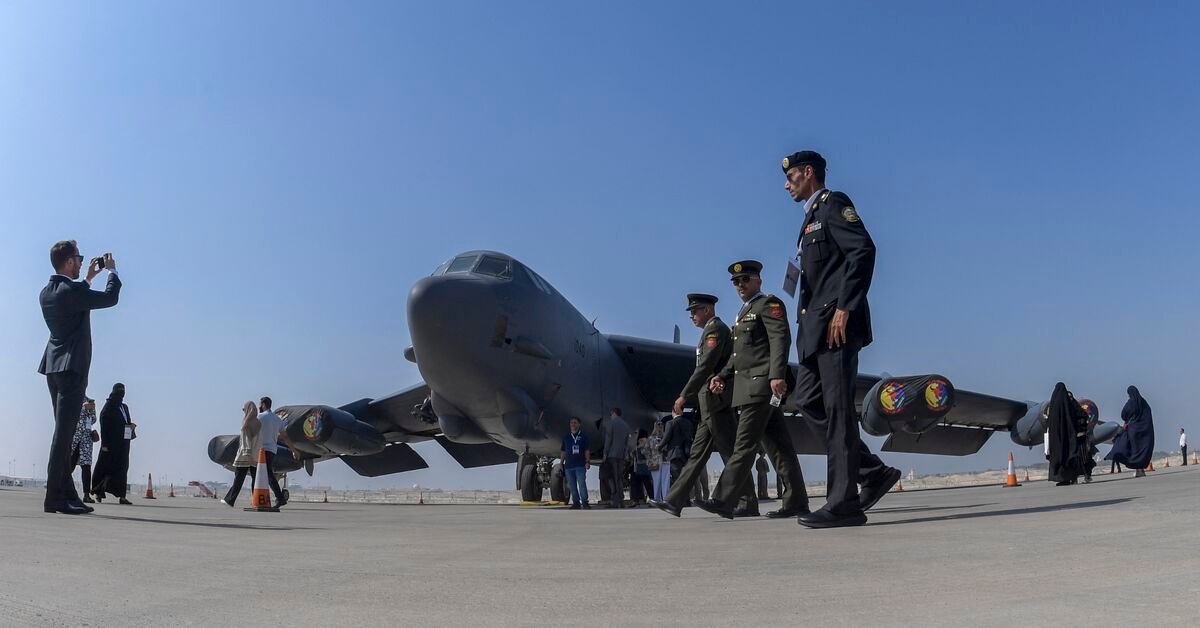WASHINGTON — A pair of US Air Force B-52 strategic bombers flew over the Gulf region on Monday as the Pentagon shuffled its forces in the area.
The bombers took off from the UK’s Royal Air Force Fairford Air Base and traversed the airspace of nine countries in the Middle East, US Central Command (CENTCOM) said Tuesday.
The bomber task force mission included midair refueling and dropping of live munitions at target ranges “in several partner nations,” CENTCOM said. US F-15s and fighter aircraft from four countries in the region provided escort for the B-52s, according to CENTCOM.
A spokesperson for the command declined to say which countries provided escorts.
Why it matters: The bomber task force mission came just days after the USS Harry S. Truman — the US Navy aircraft carrier based in the Red Sea for the last two months — suffered visible damage due to a collision with a commercial bulk carrier near Egypt’s north coast.
The Truman’s departure has left Middle Eastern waters without a US aircraft carrier for the third time since the Israel-Gaza war began in 2023.
The timing of the bomber overflight also added a display of muscle ahead of groundbreaking US diplomatic talks with Russia over the fate of Ukraine. The talks, held in Saudi Arabia on Monday, led the two adversarial powers to agree to restore previous levels of diplomatic ties and appoint working groups tasked with preparing steps to end Russia’s war in Ukraine.
US Secretary of State Marco Rubio led the US delegation in the Riyadh talks without the participation of Ukrainian officials, drawing a rebuke from Washington’s European allies, who were also excluded from the talks.
What’s next: USAF B-52 overflights were a hallmark of the first Trump administration’s attempt to intimidate Iranian leaders back to the negotiating table, after Donald Trump unilaterally withdrew from the 2015 nuclear accord with Tehran in 2018.
Iran has continued to incrementally ramp up uranium enrichment well beyond the limits imposed by the defunct 2015 accord, but US intelligence believes its leaders have not yet decided whether to weaponize its stockpiles.
Iran’s Islamic Revolutionary Guard Corps has been posturing, as Trump has called for diplomatic talks — rather than war — to halt Iran’s runaway enrichment.
The IRGC unveiled a new series of precision-guided drones in the Khuzestan province this week, following previous drills last month that Iranian officials described as exercising precision fires in the Strait of Hormuz.
US officials have described Iran as being in a militarily and economically weakened state in the months since Israeli airstrikes decimated Hezbollah and knocked out the Islamic Republic’s Russian-made S-300 air defense systems late last year.
Flashback: The Biden administration also advertised B-52 flights over the region, in some cases coupled with aerial linkups by Middle Eastern countries’ fighter aircraft in a show of force to demonstrate Tehran’s isolation amid its neighbors.
USAF B-52s were last publicly announced to have deployed to the region in November 2024 along with additional F-15s, as the USS Abraham Lincoln prepared to depart at the end of its seven-month deployment there.
The latest overflight came on the heels of the US Air Force’s biannual Agile Spartan exercise, held at various satellite bases across the Arabian Peninsula.
The war games were designed to deploy USAF and allied warplanes forward to smaller, more dispersed bases throughout the Gulf in order to practice “resilience and survivability” — euphemisms for evading mass ballistic or aerial-launched missile attacks by Iran or other US adversaries.
The multiweek exercises included multiple regional militaries aligned with the US, the US’ Ninth Air Force said. Air Force officials were similarly tight-lipped about participating nations, however, citing diplomatic sensitivities of Middle Eastern states toward their neighbor.
Last year, Saudi Arabia and the United Arab Emirates underscored their restrictions on the US Air Force’s use of their bases to launch kinetic strikes into neighboring countries.
A senior US Air Force official with responsibility in the region waved off the dispute during a brief interview with Al-Monitor last week.
“We wouldn’t be able to operate without the relationships we have,” Col. Derrick Michaud, the AFCENT division chief for future operations, said. “Our relationships are strong,” he added.
“We are able to generate combat air power wherever we go. It’ll be smaller groups, smaller footprint of people and things, but we’re still able to do it,” Michaud said.
Know more: Despite Trump’s gambit over Gaza, the prospect of a future US-Saudi defense pact in exchange for diplomatic normalization with Israel is not off the table, sources close to the discussions said.
However, Trump’s pick to become the Pentagon’s top policy chief, Elbridge Colby, has staunchly advocated a smaller US military presence in the Middle East in order to prioritize China’s threat to Taiwan in the coming years.
Colby is increasingly expected to face scrutiny from some Republican lawmakers during his upcoming Senate confirmation hearing as to whether his emphasis on Taiwan could lead the Pentagon to take its eye off the ball with Iran’s nuclear enrichment.
The Trump administration has also yet to determine the future of the US military’s footprint in Syria.
Over the weekend, US CENTCOM forces killed an alleged senior Huras al-Din leader with a drone strike in northwest Syria, earning rare public praise from Trump.
“Congratulations to CENTCOM commander Gen. Michael Kurilla, and the US warfighters who dealt justice to another jihadi threatening America and our allies and partners,” the president posted on social media.
